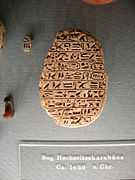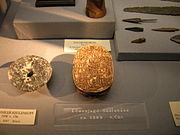During the reign of the ancient Egyptian pharaoh Amenhotep III hundreds of so-called memorial scarabs were issued to commemorate the deeds of the pharaoh. Such scarabs were found in several archaeological sites of the Near East, from Syria to Sudan. Over two hundred of them are known to exist in museums and collections around the world.
Most of the scarabs are made of steatite painted blue or green. Their length varies between 4.7 and 11 cm, their width between 7 and 8.9 cm. Most of them are pierced for threading. On the basis of their inscriptions the scarabs can be divided into five groups (in parentheses the number of scarabs of the type found on several sites):
- "lion hunt scarabs" (123)
- "marriage scarabs" (56)
- "lake scarabs" (11)
- "bull hunt scarabs" (5)
- "Gilukhepa scarabs" (5)
The scarabs are likely to have been made at the same time, in or after the 11th regnal year. The scarab beetle was a symbol of the sun god Khepri, and glazed materials were called tjehenet ('shining') in Egyptian, so the shining scarabs refer to the king, the dazzling Sun himself.
Groups
- Lion hunt
The lion hunt scarabs emphasise the pharaoh's strength and bravery by recording that Amenhotep killed over a hundred lions (102; 110 on some scarabs) during the first ten years of his reign. These have the shortest inscription (7 lines), their average length is 7,7 cm. The lion hunt scarabs vary the most in size; the smallest scarab is 4,7 cm long, the largest is more than twice its size with a length of 9,5 cm.
- Marriage
The so-called marriage scarabs actually refer not to the marriage itself, and neither do they mention a marriage date. They record the name of Amenhotep's chief queen Tiye (following that of her husband), along with the names of her parents, as if to explicitly state her non-royal birth: the name of her father is Yuya, the name of her mother is Thuya; she is married to the great king whose southern border is at Karoy and whose northern is Naharin. Tiye's importance is shown by defining the boundaries of the empire in terms of her. The length of the inscription on these scarabs is 9-10 lines, the scarabs' average length is 8,5 cm.
- Lake
The lake scarabs commemorate the construction of an artificial lake for Queen Tiye in the 11th regnal year. On these, the name and titles of the pharaoh are followed by those of Tiye, the names of her parents, then the description of the lake that was dug in Tiye's town Djaruha. The lake was 3700×700 cubits large, and the royal couple was rowed on the lake in the royal barge Aten-tjehen. The name of the boat means 'Shining Sun-disc', this is the first appearance of this name which later becomes an epithet of the king himself. The lake scarabs vary the most in their texts, but the differences don't affect the meaning of the text itself. The text is 11 lines long, the average length of these scarabs is 8,4 cm.
- Bull hunt
The bull hunt scarabs record that in the 2nd regnal year Amenhotep, followed by his soldiers and officials, went to Shetep (possibly the area of Wadi el-Natrun) on his barge Khaemmaat ('Appears in Truth'), charged at wild bulls by his chariot and killed them. On the first day he slayed 56 bulls, four days later he killed 40 of them. The bulls had been previously surrounded with a ditch.
Hunt was not only a favourite pastime for the pharaohs, it also symbolized the ruler's strength and his victory over the forces of chaos, thus it equalled victory on a battlefield. These scarabs also list the titles of the king and mention Tiye.
The bull hunt scarabs have both the greatest length (9,9 cm) and the longest text. The only scarab which doesn't have its back carved in the shape of a beetle is among these scarabs. This one has two longitudinal holes for suspension.
- Gilukhepa
The Gilukhepa scarabs commemorate the arrival of Princess Gilukhepa, daughter of Shuttarna II of Mitanni into the pharaoh's harem in the 10th regnal year. She had a retinue of 317 ladies-in-waiting. Tiye is also mentioned on the scarab. The length of the text is 10 lines, the average length of these scarabs is 7,2 cm.
Inscription of a scarab
Inscription on one of the lion hunt scarabs: [1]
Life for Horus, the Mighty Bull, appearing in truth
The Two Ladies, who establishes law and pacifies
the Two Lands; the Golden Horus, strong of arm, who smites Asians, King of Upper and Lower Egypt,
Nebmaatre, Son of Re, Amenhotep, ruler of Thebes, may he live!
King's Wife Tiye, may she live! The number of lions
His majesty brought from his shooting,
from Year 1 to Year 10
total of lions, 102.

Akhenaten, also spelled Echnaton, Akhenaton,, was an ancient Egyptian pharaoh reigning c. 1353–1336 or 1351–1334 BC, the tenth ruler of the Eighteenth Dynasty. Before the fifth year of his reign, he was known as Amenhotep IV.

Neferneferuaten Nefertiti was a queen of the 18th Dynasty of Ancient Egypt, the great royal wife of Pharaoh Akhenaten. Nefertiti and her husband were known for a religious revolution, in which they worshipped one god only, Aten, or the sun disc. With her husband, she reigned at what was arguably the wealthiest period of ancient Egyptian history. Some scholars believe that Nefertiti ruled briefly as Neferneferuaten after her husband's death and before the ascension of Tutankhamun, although this identification is a matter of ongoing debate. If Nefertiti did rule as Pharaoh, her reign was marked by the fall of Amarna and relocation of the capital back to the traditional city of Thebes.
Montu was a falcon-god of war in ancient Egyptian religion, an embodiment of the conquering vitality of the pharaoh. He was particularly worshipped in Upper Egypt and in the district of Thebes.
[Ramesses II] whom victory was foretold as he came from the womb,
Whom valor was given while in the egg,
Bull firm of heart as he treads the arena,
Godly king going forth like Montu on victory day.

Tiye was the daughter of Yuya and Thuya. She became the Great Royal Wife of the Egyptian pharaoh Amenhotep III. She was the mother of Akhenaten and grandmother of Tutankhamun. In 2010, DNA analysis confirmed her as the mummy known as "The Elder Lady" found in the tomb of Amenhotep II (KV35) in 1898.

Amenhotep III, also known as Amenhotep the Magnificent or Amenhotep the Great, was the ninth pharaoh of the Eighteenth Dynasty. According to different authors, he ruled Egypt from June 1386 to 1349 BC, or from June 1388 BC to December 1351 BC/1350 BC, after his father Thutmose IV died. Amenhotep was Thutmose's son by a minor wife, Mutemwiya.

Tadukhipa, in the Hurrian language Tadu-Hepa, was the daughter of Tushratta and his queen Juni, and niece of Artashumara. Tadukhipa's aunt Gilukhipa had married Pharaoh Amenhotep III in his 10th regnal year. Tadukhipa was to marry Amenhotep III more than two decades later.
Gilukhipa, or more probable Kilu-Hepa in Hurrian language, in the Egyptian language Kirgipa, was the daughter of Shuttarna II, king of Mitanni. She was the sister of Tushratta, Biria-Waza and Artashumara.

The Sed festival was an ancient Egyptian ceremony that celebrated the continued rule of a pharaoh. The name is taken from the name of an Egyptian wolf god, one of whose names was Wepwawet or Sed.

Sitamun, also Sitamen,Satamun; Ancient Egyptian: sꜣ.t-imn, "daughter of Amun" was an ancient Egyptian princess and queen consort during the 18th Dynasty.
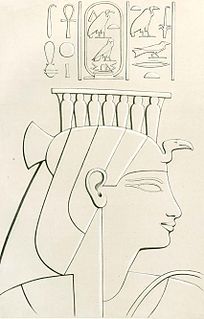
Mutemwiya was a minor wife of the Eighteenth Dynasty pharaoh Thutmose IV, and the mother of Pharaoh Amenhotep III. Mutemwiya's name means "Mut in the divine barque". While unconfirmed, it has been suggested that she acted as regent during the minority of her son Amenhotep III.
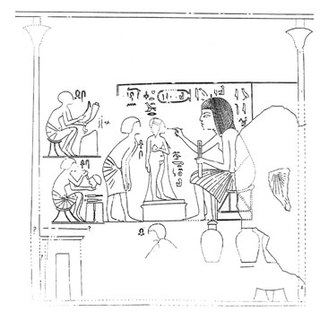
Beketaten (14th century BCE) was an ancient Egyptian princess of the 18th Dynasty. Beketaten is considered to be the youngest daughter of Pharaoh Amenhotep III and his Great Royal Wife Tiye, thus the sister of Pharaoh Akhenaten. Her name means "Handmaid of Aten".

Scarabs were popular amulets and impression seals in ancient Egypt. They survive in large numbers and, through their inscriptions and typology, they are an important source of information for archaeologists and historians of the ancient world. They also represent a significant body of ancient art.
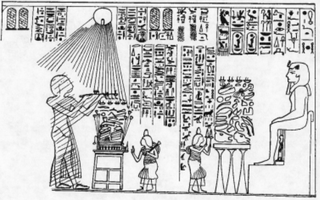
Bek or Bak was the first chief royal sculptor during the reign of Pharaoh Akhenaten. His father Men held the same position under Akhenaten's father Amenhotep III; his mother Roi was a woman from Heliopolis.
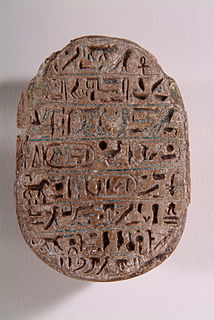
The Lion-Hunts of Amenhotep III During the First Ten Years of his Reign is one of a group of five historical and commemorative scarabs made during the reign of Amenhotep III. The set of five scarabs were presumably used to validate, and proclaim his choice of Tiye as his wife.

The Younger Lady is the informal name given to a mummy discovered within tomb KV35 in the Valley of the Kings by archaeologist Victor Loret in 1898. The mummy also has been given the designation KV35YL and 61072, and currently resides in the Egyptian Museum in Cairo. Through recent DNA tests, this mummy has been identified as the mother of the pharaoh Tutankhamun and a daughter of pharaoh Amenhotep III and his Great Royal Wife Tiye. Early speculation that this mummy was the remains of Nefertiti was argued to be incorrect, as nowhere is Nefertiti accorded the title "King's daughter."
Ahmose called Turo was Viceroy of Kush under Amenhotep I and Thutmose I.

The Eighteenth Dynasty of Egypt is classified as the first dynasty of the New Kingdom of Egypt, the era in which ancient Egypt achieved the peak of its power. The Eighteenth Dynasty spanned the period from 1550/1549 to 1292 BC. This dynasty is also known as the Thutmosid Dynasty for the four pharaohs named Thutmose.
This page list topics related to ancient Egypt.
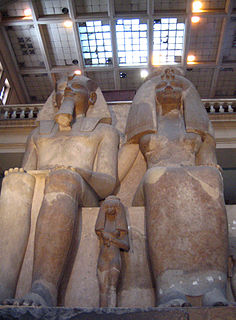
The colossal statue of Amenhotep III and Tiye is a monolith group statue of Egyptian pharaoh Amenhotep III of the eighteenth dynasty, his Great Royal Wife Tiye, and three of their daughters. It is the largest known dyad ever carved. The statue originally stood in Medinet Habu, Western Thebes; today it is the centerpiece of the main hall of the Egyptian Museum in Cairo.
Catharina Blankenberg-van Delden was a Dutch Egyptologist.

